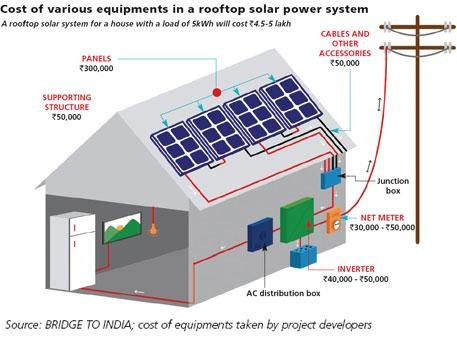Why in News
- To increase adoption of house-hold rooftop solar systems (h-RTS) through the Pradhan Mantri Suryodaya Yojana, the Centre is likely to bear the entire cost of setting up such systems for households that consume less than 300 units of electricity a month.
- This could potentially cost at least 1 lakh crore, and in a departure from the existing approach to h- RTS, it will see Union government companies – as opposed to the current set- up of individual State-run power distribution companies taking up the responsibility of powering beneficiary households.
Prior initiatives to increase solar system usage:
- The government launched the Rooftop Solar Program in 2014 to achieve accumulative installed capacity of 40,000 megawatts (MW) or 40gigawatts (GW) by 2022.
- Know more about Watt: Watt is a unit of power and is calculated as the amount of energy used over time, specifically one Joule per second.
- The program’s objective was to increase the amount of rooftop solar installed capacity in India’s residential market by offering incentives and Central Financial Assistance to distribution firms, or DISCOMs.
- However government missed the target as solar generation through this scheme by end of 2023 was 11GW and generated energy from residents was only one fifth of 11GW, so government decided to extend this scheme till 2026.
Features and challenges of rooftop solar program
- Consumer can visit national portal solarrooftop.gov.in to avail benefits of scheme.
- DISCOMS will only take care of installation of net meters, approvals of technical feasibility and system inspection.
- Net metering is a billing mechanism that credits solar energy system owners for the electricity they add to the grid.
- After installation surplus solar units will be exported to the grid and consumers will get monetary benefit directly in the bank as per state regulations and guidelines.
- The schemes face various challenges in its implementation such as, lack of awareness in residents and customers, high installation costs and different state policies across states.
Recently announced Pradhan Mantri Suryodaya Yojana
- This is fresh approach by government to reach 40GW target of solar rooftops.
- This will be achieved by installing rooftops at residents’ rooftops.
- This scheme will push for dual goal of reducing electricity bills of residents as well as taking India forward to become self-reliant in solar energy.
Let’s look at India’s current solar capacity
- Currently India’s solar powered capacity is at 73GW, out of which share of solar energy though rooftop stands at just 11GW.
- Solar energy has major share in India’s total renewable energy capacity which stands at 180GW.
- With total solar capacity of 18GW and 10.5GW Rajasthan and Gujarat tops the list.
- In rooftop solar category, Gujarat stands at 2.8GW and Maharashtra at 1.7GW.
Need to expand solar energy in India
- The International Energy Agency (IEA) has released its most recent World Energy Outlook, which predicts that over the next 30 years, India’s energy demand would increase more than that of any other nation or area worldwide.
- An intergovernmental body called IEA offers information, analysis, and policy recommendations about the world’s energy market. The IEA wants to support nations in providing secure and sustainable energy to all people.
- To meet future energy demand India needs to improve on all renewable energy fronts to reduce its dependence on fossil fuel and coal.
For More Detail Read this Article
FAQ
1. What is pradhan mantri suryoday yojana?
Ans : The Pradhan Mantri Suryodaya Yojana seeks to finance additional power generation in addition to providing homes with electricity from solar rooftop systems. On January 22, 2024, Prime Minister Narendra Modi made this declaration.
2.What is India’s current solar scheme?
Ans: The government launched the Rooftop Solar Program in 2014 to achieve accumulative installed capacity of 40,000 megawatts (MW) or 40gigawatts (GW) by 2022.
3.Where India stands at its solar capacity?
Ans: Currently India’s solar powered capacity is at 73GW, out of which share of solar energy though rooftop stands at just 11GW.
4.Which states in India produces more solar energy?
Ans: With total solar capacity of 18GW and 10.5GW Rajasthan and Gujarat tops the list. In rooftop solar category, Gujarat stands at 2.8GW and Maharashtra at 1.7GW.

Thanks for sharing. I read many of your blog posts, cool, your blog is very good.